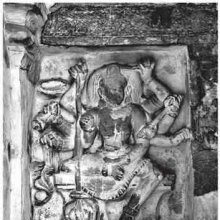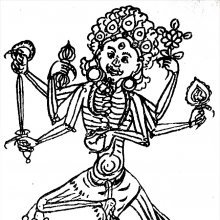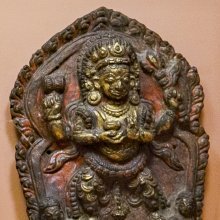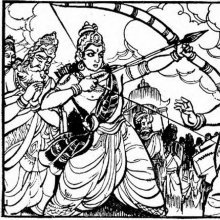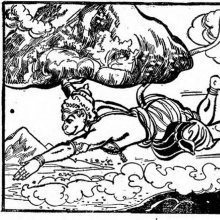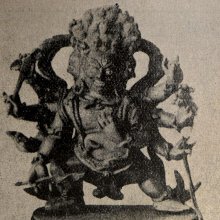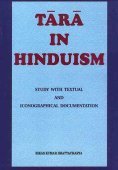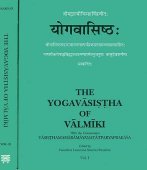Terrible: 3 definitions
Introduction:
Terrible means something in Hinduism, Sanskrit. If you want to know the exact meaning, history, etymology or English translation of this term then check out the descriptions on this page. Add your comment or reference to a book if you want to contribute to this summary article.
Images (photo gallery)
(+30 more images available)
In Hinduism
Gitashastra (science of music)
Source: Shodhganga: Elements of Art and Architecture in the Trtiyakhanda of the Visnudharmottarapurana (gita)The Terrible Sentiment (in Sanskrit: bhayānaka-rasa) refers to one of the nine kinds of Sentiment (rasa) in Indian classical Music. They have an inherent relationship with the svaras (“musical notes”).—There are nine kinds of sentiments: [e.g., Terrible (bhayānaka)]. In the Nāṭyaśāstra some particular svaras are determined for the delineation of some specific sentiments. In the Nāṭyaśāstra it is accepted that—the note dhaivata is used to delineate the sentiments of bībhatsa and bhayānaka.
Gitashastra (गीतशास्त्र, gītaśāstra) refers to the ancient Indian science of Music (gita or samgita), which is traditionally divided in Vocal music, Instrumental music and Dance (under the jurisdiction of music). The different elements and technical terms are explained in a wide range of (often Sanskrit) literature.
Natyashastra (theatrics and dramaturgy)
Source: Shodhganga: Elements of Art and Architecture in the Trtiyakhanda of the Visnudharmottarapurana (natya)The Terrible Sentiment is denoted by the Sanskrit term Bhayānaka-rasa, which represents one of the nine kinds of Rasa (“soul of Drama”), according to the Viṣṇudharmottarapurāṇa, an ancient Sanskrit text which (being encyclopedic in nature) deals with a variety of cultural topics such as arts, architecture, music, grammar and astronomy.—According to the Viṣṇudharmottarapurāṇa bhayānaka is the sentiment of fear which arises from the commitment of a self committing offence. In the Viṣṇudharmottarapurāṇa, bhayānakarasa (the terrible sentiment) is accepted as the result of bībhatsa. In the Nāṭyaśāstra, Bharata gives numerous causes of fear viz., horrible noise, sight of ghosts, sound of jackal and owls, scene of dark forest, sight of death or imprisonment of dear ones etc.

Natyashastra (नाट्यशास्त्र, nāṭyaśāstra) refers to both the ancient Indian tradition (shastra) of performing arts, (natya—theatrics, drama, dance, music), as well as the name of a Sanskrit work dealing with these subjects. It also teaches the rules for composing Dramatic plays (nataka), construction and performance of Theater, and Poetic works (kavya).
Shilpashastra (iconography)
Source: Shodhganga: Elements of Art and Architecture in the Trtiyakhanda of the Visnudharmottarapurana (shilpa)The Terrible (sentiment) refers to one of the Nine Sentiments (citrarasa) in ancient Indian Painting (citra), according to the Viṣṇudharmottarapurāṇa, an ancient Sanskrit text which (being encyclopedic in nature) deals with a variety of cultural topics such as arts, architecture, music, grammar and astronomy.—Painting is a medium of showing the inner feelings and emotions of a painter which can strikes the inherent sentiments of connoisseur’s mind [e.g., the terrible sentiment (bhayānaka)]. [...] According to the Viṣṇudharmottarapurāṇa, bhayānakarasa can be manifested in a Painting through the portrayal of wicked or terrible looking persons engaged in crazy and violent activities. It can be deduced that if a painter paints the picture of the scene of abduction of Sītā by Rāvaṇa as described in the 49th chapter of the Araṇyakāṇḍa of the Rāmāyaṇa, it would definitely reflect the sentiment of fear.
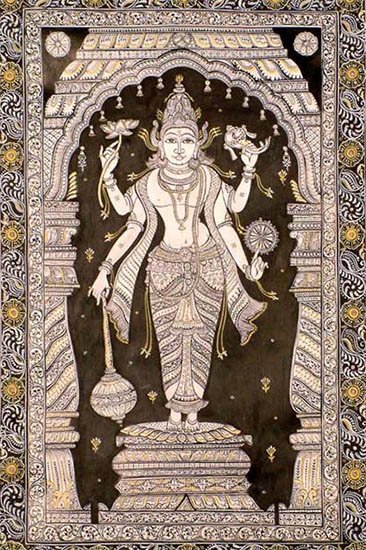
Shilpashastra (शिल्पशास्त्र, śilpaśāstra) represents the ancient Indian science (shastra) of creative arts (shilpa) such as sculpture, iconography and painting. Closely related to Vastushastra (architecture), they often share the same literature.
See also (Relevant definitions)
Full-text (+1017): Bhayanaka, Bhayankara, Raudra, Sudaruna, Ghora, Proccanda, Karala, Bhima, Pracanda, Aghora, Pratibhaya, Bhemsura, Ramyadaruna, Abhila, Akaralavikarala, Ugrashravanadarshana, Krura, Bhayavaha, Bhayanak, Damshtrakarala.
Relevant text
Search found 242 books and stories containing Terrible; (plurals include: Terribles). You can also click to the full overview containing English textual excerpts. Below are direct links for the most relevant articles:
What is Creative Art? < [July – September, 1988]
The Terrible Sonnets of Gerard Manley Hopkins < [April – June, 1983]
Sacrifice < [December 1939]
The Padma Purana (by N.A. Deshpande)
Chapter 70 - Sinners in Hell < [Section 2 - Bhūmi-khaṇḍa (section on the earth)]
Chapter 74 - The Slaying of Tripura’s Son < [Section 1 - Sṛṣṭi-khaṇḍa (section on creation)]
Chapter 91 - Vidura, Candraśarman, Vedaśarman and Vañjula < [Section 2 - Bhūmi-khaṇḍa (section on the earth)]
The Gautami Mahatmya (by G. P. Bhatt)
The Shiva Purana (by J. L. Shastri)
Chapter 7 - Pathway to Hell and the Emissaries of Yama < [Section 5 - Umā-Saṃhitā]
Chapter 46 - Andhaka fights < [Section 2.5 - Rudra-saṃhitā (5): Yuddha-khaṇḍa]
Chapter 9 - Pangs of hell < [Section 5 - Umā-Saṃhitā]
The Brahma Purana (by G. P. Bhatt)
Chapter 106 - Tortures in Hell
Chapter 50 - Mārkaṇḍeya views annihilation
The Skanda Purana (by G. V. Tagare)
Chapter 15 - Efficacy of the Holy Ash < [Section 3 - Brāhmottara-khaṇḍa]
Chapter 15 - Turbulence of the Annihilation (Pralaya) < [Section 3 - Revā-khaṇḍa]
Chapter 53 - Viśveśvara (viśva-īśvara-liṅga) < [Section 2 - Caturaśīti-liṅga-māhātmya]
Related products
